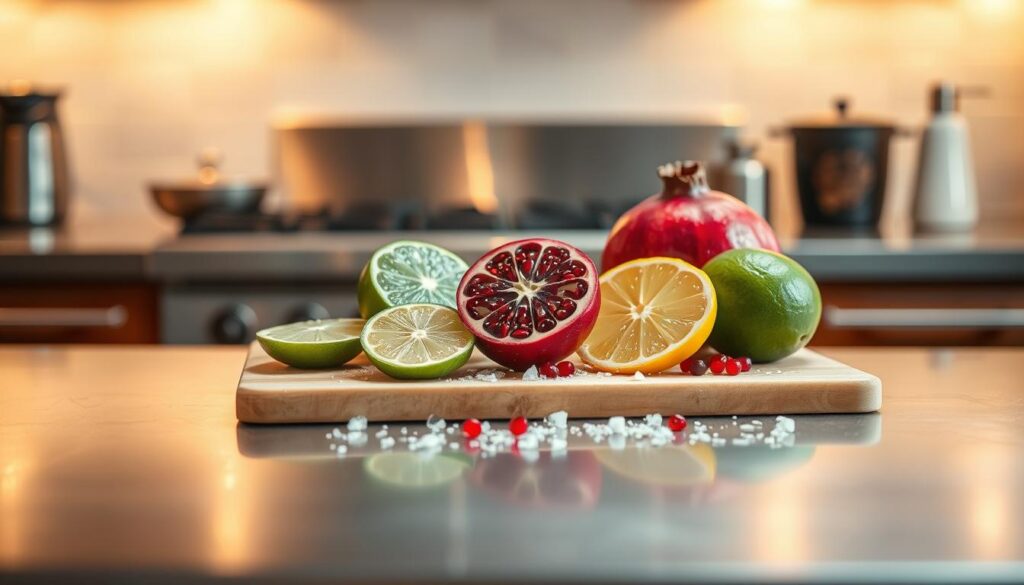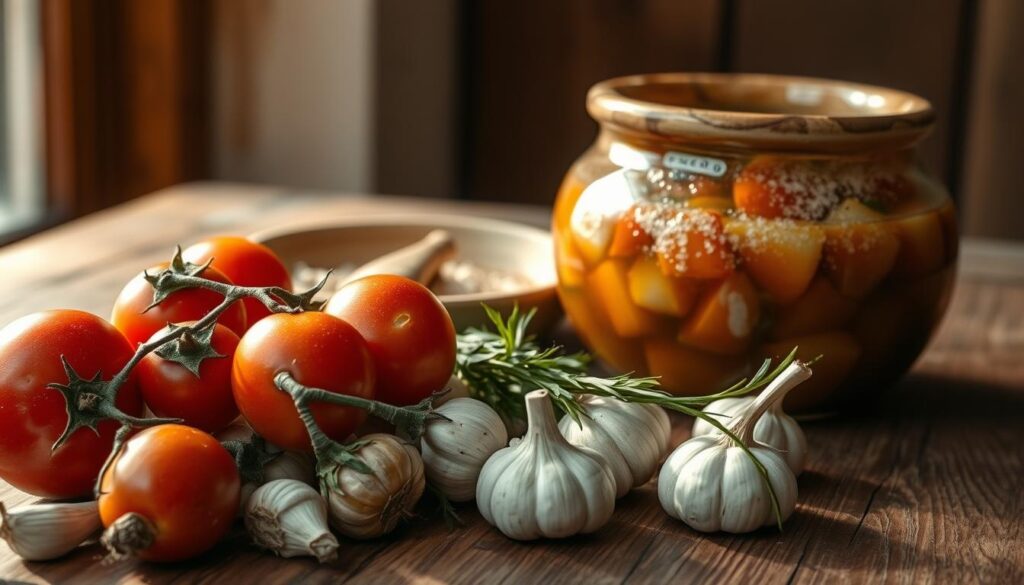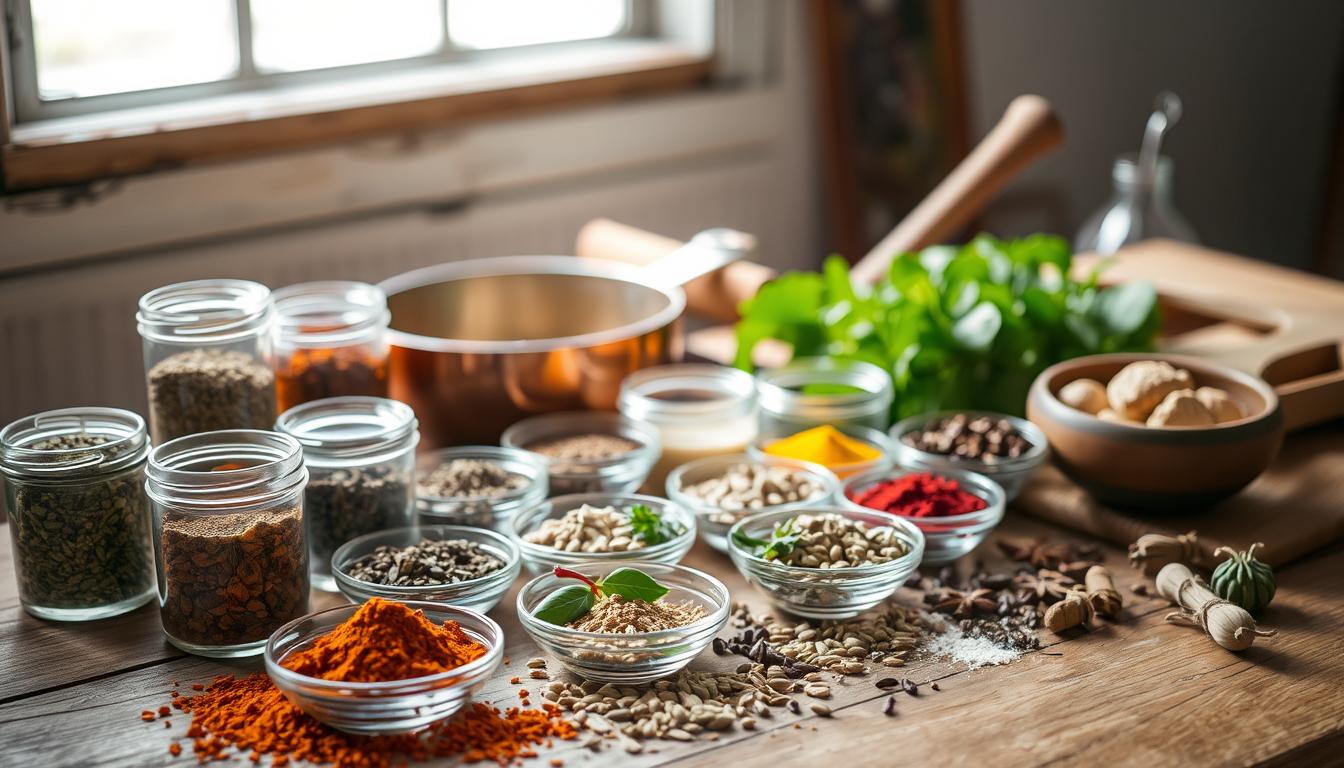A great meal can bring people together. As home cooks, we’re always looking for ways to improve our dinner recipes. Secret ingredients like truffle oil, anchovy paste, and miso paste can add a unique twist to our dishes.
Exploring flavor enhancers, we find that fresh herbs are a favorite among registered dietitians. Ingredients like Better Than Bouillon and Laoganma Chili Crisp also add depth to our cooking. With the right tips and enhancers, we can make dinner recipes that impress.
Using secret ingredients can make our dinner flavors better. By adding citrus zest, soy sauce, and smoked seasonings, we can enhance our dishes. In this article, we’ll explore how to use these ingredients to elevate our cooking.
Introduction to Secret Ingredients
Secret ingredients go beyond spices and herbs. They include fish sauce, curry powder, and tahini. These ingredients can give our dishes a unique flavor and make them stand out.
Key Takeaways
- Using secret ingredients can elevate our dinner flavors and make our meals more enjoyable.
- Fresh herbs are a versatile flavor enhancer that can be used in a variety of dishes.
- Flavor enhancers like truffle oil, anchovy paste, and miso paste can add depth and complexity to our cooking.
- Cooking tips like using citrus zest, soy sauce, and smoked seasonings can add brightness and depth to our meals.
- Experimenting with different ingredients and flavor combinations can help us discover new dinner recipes and cooking tips.
- Secret ingredients like fish sauce, curry powder, and tahini can add a unique flavor profile to our dishes.
- Using high-quality ingredients like condiment-grade vinegar and duck fat can make a big difference in the taste and aroma of our meals.
Understanding the Importance of Flavor Profiles
Understanding flavor profiles is key in cooking. It helps us make dishes that taste great. By knowing how different tastes and smells work together, we can mix ingredients to get the flavor we want. This is where kitchen hacks and secret dinner ingredients help us improve our cooking.
Flavors work together in special ways. Sweetness can balance out saltiness and bitterness. Salt, on the other hand, can make other flavors pop. Umami, or the fifth taste, adds a rich depth to food. It’s found in things like soy sauce, mushrooms, and aged cheeses. Knowing how these flavors interact helps us create dishes that taste balanced and good.
- Sweetness, saltiness, bitterness, sourness, and umami are the five main flavor profiles.
- Each flavor profile has its own role in making a dish taste better.
- Knowing how flavors work together is key to making tasty dishes.
By using these tips and adding kitchen hacks and secret dinner ingredients to our cooking, we can make our dishes stand out. We can create unforgettable meals.
Herbs and Spices that Transform Dishes
Herbs and spices are key to great cooking. They can turn a simple dish into something amazing. The global spice market is growing fast, showing people love new tastes. A great cooking hack is to try different herbs and spices for elevated flavors.
Herbs like rosemary, basil, and oregano can do more than just add flavor. Rosemary makes a tasty roasted chicken, while basil is great in pesto. Spices like cumin, paprika, and turmeric add warmth and depth. Turmeric, for example, has curcumin, which is good for fighting inflammation and protecting against damage.
Here are some benefits of using herbs and spices:
- Can add depth and complexity to dishes
- Can be used to create unique flavor combinations
- Can have health benefits, such as reducing inflammation and improving heart health
Adding herbs and spices to our cooking makes dishes tasty and healthy. Whether we use fresh herbs or spices, the goal is to find the perfect mix. With a bit of creativity and cooking hacks, we can impress everyone with our elevated flavors.
| Herb/Spice | Benefits | Uses |
|---|---|---|
| Rosemary | Improves digestion, reduces inflammation | Roasted chicken, soups, stews |
| Turmeric | Anti-inflammatory, antioxidant properties | Curries, soups, stews |
| Cumin | Aids digestion, boosts immunity | Stews, curries, salads |
Umami: The Overlooked Flavor
Umami is the fifth taste, along with sweet, sour, bitter, and salty. It’s a savory taste found in meats, veggies, and seafood. Adding flavor enhancers rich in umami can boost our dinner recipes.
Ingredients like glutamic acid, inosinate, and guanylate are packed with umami. Glutamic acid is found in both plants and animals. Inosinate is in meats and fish, while guanylate is in mushrooms.
Ingredients Rich in Umami
Here are some umami-rich ingredients:
- Smoked meats, like ham, bacon, and sausage
- Miso paste, from soybeans or rice
- Anchovies, adding umami to Caesar salad dressing and beef stew
- Dried mushrooms, like Shiitake, for plant-based umami
How to Incorporate Umami into Meals
To add umami, use enhancers like fish sauce, soy sauce, and sun-dried tomatoes. These add depth and complexity to our meals, making them more delicious.
Understanding umami and using umami-rich ingredients can make our meals more flavorful. Whether cooking for ourselves or others, these enhancers can greatly improve taste and enjoyment.
| Ingredient | Umami Content |
|---|---|
| Glutamic acid | High |
| Inosinate | Medium |
| Guanylate | Low |
Acidic Ingredients for Brightness
Using acidic ingredients is a key cooking tip that many overlook. Ingredients like lemon juice and vinegar are essential for balancing flavors. They help make our dishes more vibrant and tasty.
Understanding the different acidic ingredients is important. Citrus juices and various vinegars each have their own uses. For instance, balsamic vinegar adds a sweet-and-sour taste, while lemon juice brings a fresh citrus flavor.

To balance acidity, we can use fats or sugars. An acid and oil vinaigrette is a good starting point. Start with one tablespoon of oil and add more while tasting. This way, we can make dishes that are both balanced and delicious.
Here are some key tips for using acidic ingredients:
- Start with small amounts and taste as you go, adjusting the acidity to your liking.
- Experiment with different types of acidic ingredients to find the ones that work best for you.
- Don’t be afraid to add a bit of sugar or fat to balance out overly sour flavors.
Sweetness as a Secret Ingredient
When we talk about elevated flavors in dinner recipes, sweetness is often overlooked. Yet, a hint of sweetness can balance out savory flavors. It adds depth to dishes. We can use natural sweeteners like honey or maple syrup to enhance our dinner recipes.
Dark chocolate is a great example of using sweetness in savory dishes. A small amount can add a rich, deep flavor to stews or braises. Brown sugar or coconut sugar can also add a touch of sweetness to dinner recipes.
Here are some tips for using sweetness wisely in dinner recipes:
* Use a small amount of sweetener to balance out savory flavors.
* Choose natural sweeteners like honey or maple syrup.
* Try different types of sweeteners to find the best one for your recipe.
By adding a touch of sweetness, we can create elevated flavors. These will impress our guests and leave them wanting more.
The Power of Fats and Oils
Fats and oils are key to making any dish stand out. The right type can turn a simple recipe into something amazing. We use cooking hacks like flavored oils to boost our dishes’ flavors. For example, ajillo oil adds a touch of elegance to our meals.
Fats and oils are vital for adding depth to our food. Each type has its own unique taste. Sesame oil has a nutty flavor, while coconut oil is creamy. Choosing the right fat or oil makes our dishes not just tasty but also beautiful.
Here are some flavored oils that can take our dishes to the next level:
- Ajillo: a type of flavored oil made with garlic and chili peppers
- Truffle oil: a type of flavored oil made with truffles and olive oil
- Lemon oil: a type of flavored oil made with lemon zest and olive oil
Using these flavored oils in our cooking can make our dishes unique and exciting. Whether we’re using cooking hacks or flavor enhancers, the key is to experiment. Find the right mix that suits your taste.
| Type of Fat or Oil | Flavor Profile | Uses |
|---|---|---|
| Sesame oil | Nutty, earthy | Stir-fries, marinades, salad dressings |
| Coconut oil | Rich, creamy | Baking, sautéing, making desserts |
| Olive oil | Fruity, peppery | Salad dressings, marinades, roasting vegetables |
Stocks and Broths for Depth of Flavor
Using high-quality stocks and broths can greatly improve a dish’s flavor and texture. Homemade stocks give us control over ingredients and sodium levels. With a few simple tips, we can make healthy stocks that add depth to our meals.
To make flavorful broths, we should use different base ingredients like various mushrooms or beef cuts. Cooking below boiling point helps concentrate flavors. Adding small amounts of rock sugar can also enhance and balance the broth’s taste. By trying different ingredients, we can make a variety of tasty dinner recipes.
- Use a variety of base ingredients to add depth and complexity to the broth
- Cook below the boiling point to concentrate flavors
- Add small increments of rock sugar to balance and enhance flavors
By using these tips in our dinner recipes, we can make healthy and delicious meals that impress everyone.
Fermented Ingredients for Complexity
Fermented ingredients can add depth and complexity to our dishes. They are known for their unique flavors. For example, kimchi adds a tangy, spicy taste to meals.
Miso, tempeh, and kefir are key fermented ingredients to try. Miso, made from fermented soybeans, adds umami to soups and sauces. Tempeh, a high-fiber food, is great as a protein source. Kefir, a fermented dairy, adds probiotics and tenderness to baked goods.
Using ferments can make our dishes more sophisticated. For instance, miso can replace salt in marinades, cutting down sodium while boosting flavor. Fermented ingredients like gochujang add a rich, umami taste. These hacks help us create dishes with complex and elevated flavors.

- They add complexity and depth to dishes
- They can elevate the flavors of meals
- They are a great source of probiotics and umami flavor
- They can be used to reduce sodium content in dishes
Adding fermented ingredients to our cooking makes meals delicious and complex. Whether it’s miso, tempeh, or kefir, these ingredients bring sophistication and enhance flavors.
The Role of Texture in Flavor Perception
Texture is key in cooking. The right mix of textures can make a dish stand out. We use flavor enhancers to add depth, and texture is a big part of that.
Studies show that matching taste and texture makes food more enjoyable. Sweet-soft and salty-crispy combos are great examples. This knowledge helps us make dishes that taste good and look great.
Why Texture Matters
Texture changes how we taste food. Different textures can make flavors pop. For example, crunchiness brings out freshness, while smoothness highlights richness.
Ingredients for Crunch and Creaminess
To add crunch, try nuts, seeds, or crispy veggies. For creaminess, use sauces, creams, or soft cheeses. Mixing these textures makes meals more interesting.
Balancing Textures in a Dish
It’s important to balance textures in a dish. This creates a harmonious eating experience. By using various ingredients and techniques, we can make food that’s tasty and looks good.
| Texture | Ingredients | Techniques |
|---|---|---|
| Crunchy | Nuts, seeds, crispy vegetables | Roasting, grilling, frying |
| Creamy | Sauces, creams, soft cheeses | Whipping, blending, simmering |
Condiments and Sauces that Wow
Condiments and sauces are key to making our dinner recipes stand out. With clever cooking hacks, we can turn a basic dish into a work of art. Exploring new condiments and making our own sauces is a great way to do this.
Try using truffle salt and beef demi glace to add depth to your dishes. Don’t forget to play with different vinegars like red wine and rice wine vinegar. They can really boost your sauce’s flavor.
- Start with a base ingredient, such as mayonnaise or Greek yogurt
- Add flavor enhancers, such as Dijon mustard or Sriracha
- Experiment with different seasonings and spices to find the perfect combination
By using these tips and adding the right condiments and sauces, we can elevate our cooking. We’ll impress everyone with our skills.
Seasonal Ingredients for Fresh Flavor
Exploring cooking, we often miss the value of seasonal ingredients. They add fresh flavor to our dishes. The farm-to-table movement is growing, focusing on local produce in 2025.
Choosing seasonal ingredients has many benefits. Fresh herbs are packed with antioxidants and nutrients like iron and calcium. Popular herbs include rosemary, dill, and basil.
To use seasonal ingredients, try these tips:
- Visit your local farmers’ market for fresh produce.
- Try new recipes with seasonal ingredients.
- Use fresh herbs to brighten your dishes.
By using these tips, you can make dishes with amazing flavors. Always pick fresh, seasonal produce for the best taste and nutrition.
| Seasonal Ingredient | Nutritional Value | Cooking Tips |
|---|---|---|
| Fresh Herbs | Rich in antioxidants and nutrients | Add to dishes for brightness and flavor |
| Seasonal Vegetables | High in vitamins and minerals | Use in salads, soups, and stir-fries |
| Local Produce | Supports local farmers and economy | Visit farmers’ markets to find fresh produce |
Final Thoughts on Elevating Dinner Flavors
There are many cooking hacks and flavor enhancers to make dinner recipes special. Nutritional yeast adds a rich umami taste. Citric acid brings a refreshing zing to dishes.
Try out these dinner recipes and techniques. It’s fun to explore new flavors. Don’t hesitate to mix spices, try fermented foods, or unique flavor mixes. The kitchen is your playground, full of endless possibilities.
Every great chef began with practice and curiosity. Enjoy learning, finding new tastes, and making dishes that wow others. Embrace the journey and let your cooking skills grow.

